Introduction to Ligamentum Mucosum and Knee Joint Dynamics
The ligamentum mucosum (LM), often overlooked, is an important synovial fold within the knee joint that may significantly influence knee stability, pain, and the progression of osteoarthritis. This article explores the anatomy, variations, clinical significance, diagnostic implications, and treatment considerations related to the ligamentum mucosum, especially focusing on its role in knee pain and osteoarthritis.
Anatomy and Morphology of the Ligamentum Mucosum
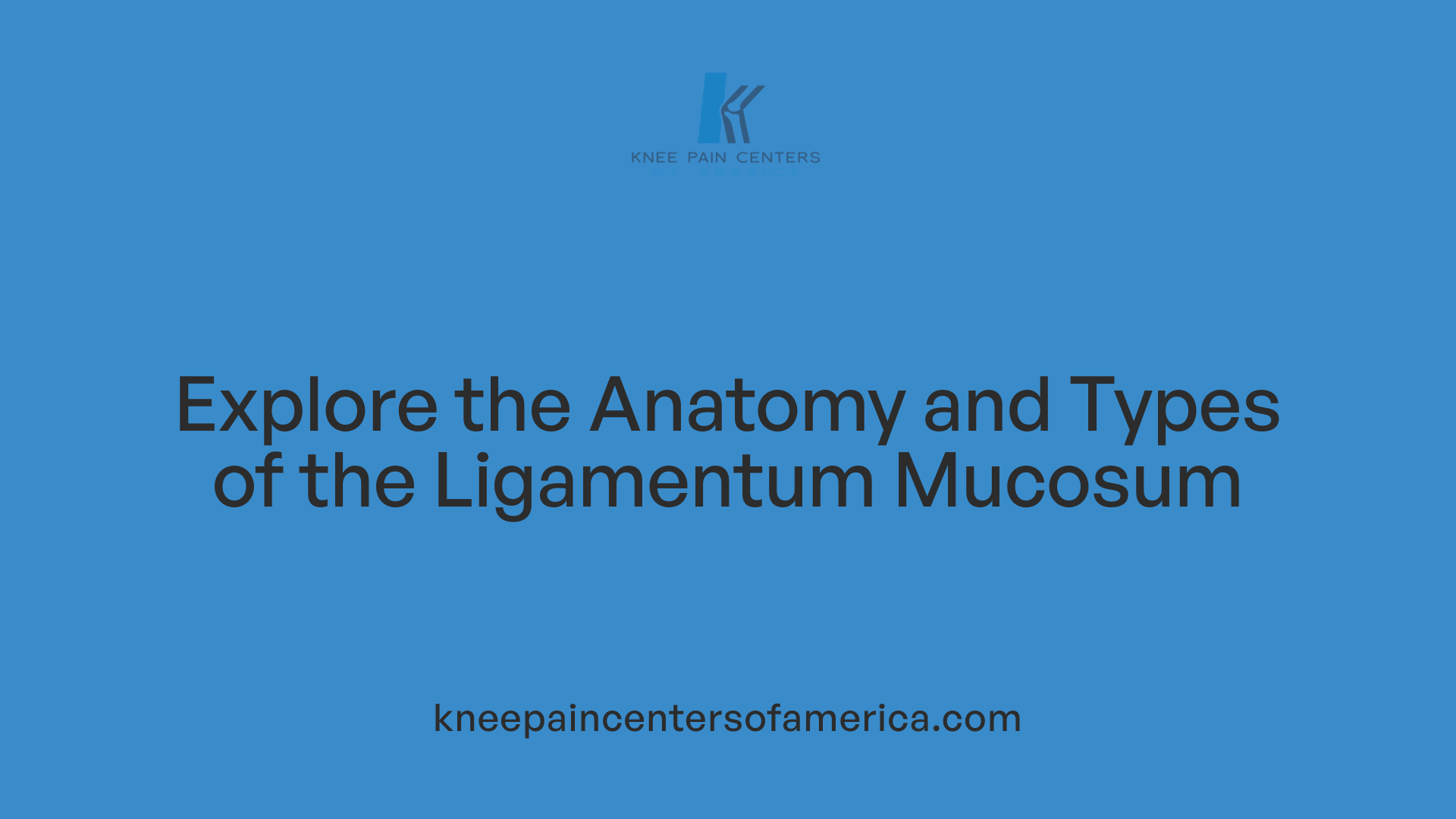
Origin and insertion of LM
The ligamentum mucosum (LM), also known as the infrapatellar plica, is a ligamentous structure located within the synovial layer of the knee joint capsule. It originates from the intercondylar notch of the femur and inserts into the infrapatellar fat pad. This anatomical positioning places the LM centrally within the knee joint, bridging critical soft tissue structures and being enveloped by the synovial membrane.
Morphological types of LM
Studies have identified various morphological types of the LM, highlighting significant variability. The most common is the single band type (Type I), observed in approximately 85% of specimens. Other variations include double bands (Type 2a and 2b) with attachments either to the anterior cruciate ligament (ACL) or the intercondylar notch, and a rare vertical septum (Type 3) that can divide the knee joint into compartments. Some classifications recognize bifurcated and triple band types, underlining the ligament's complex morphology.
Histological composition and physical characteristics
Histologically, the LM is composed primarily of dense regular connective tissue made up of Type I collagen bundles and fibrocytes, similar to other knee ligaments. It exhibits rich vascularization and is covered by a synovial membrane, containing embedded blood vessels and nerves. Physically, the ligament averages around 28.16 mm in length and 8.4 mm in width, with an increasing thickness from proximal to distal ends. Despite structural similarities to other ligaments, the LM has weaker tensile strength, suggesting it plays a minor but important role in knee stabilization and mobility.
Variability and Classification of Ligamentum Mucosum Types

Types of Ligamentum Mucosum (LM)
The ligamentum mucosum (LM), also known as the infrapatellar plica, exhibits significant variability in its morphology. Studies report several types of LM:
- Single band (Type I): The most common type, found in approximately 85% of cases, appearing as a single ligamentous band.
- Bifurcated ligaments: Includes two subtypes:
- Type IIa: Bifurcated with attachment to the anterior cruciate ligament (ACL).
- Type IIb: Bifurcated with attachment to the intercondylar notch.
- Double or triple bands: Some knees exhibit multiple bands, including rare instances of a vertical septum (Type III) that divides the joint into two compartments.
- Fenestra and absent types: Less commonly, the LM may show fenestrations or be completely absent.
Clinical Relevance of Morphological Differences
The variation in LM shape affects its functional and clinical significance. For instance, the vertical septum and split types may provide increased mechanical support to the knee, correlating with lower osteoarthritis levels. Conversely, absence of the LM has been linked to higher overall osteoarthritis severity.
Certain bifurcated types, particularly Type IIa with attachment to the ACL, may impact knee stability and are associated with anterior knee pain, complicating ACL injury diagnosis and management. Thickened or traumatized LMs have been implicated in anterior knee pain syndromes, highlighting the importance of recognizing morphological variations in clinical evaluations.
Proposed Classification Systems
Due to the high variability of LM morphologies, researchers have proposed new classification schemes to better categorize and understand their clinical implications. One proposed classification recognizes four types:
| Type |
Description |
Clinical Significance |
| I |
Single band |
Most common, generally considered normal anatomy |
| IIa |
Bifurcated ligament attached to ACL |
May cause anterior knee pain and confound ACL injury assessment |
| IIb |
Bifurcated ligament attached to intercondylar notch |
Less common, clinical implications less defined |
| III |
Double ligament with independent bands |
Could contribute to joint compartmentalization and symptomatology |
This nuanced classification enables clinicians to tailor diagnostic strategies and treatment plans according to the LM type present, ultimately improving patient outcomes related to anterior knee pain and osteoarthritis progression.
The Ligamentum Mucosum’s Role in Knee Stability and Motion
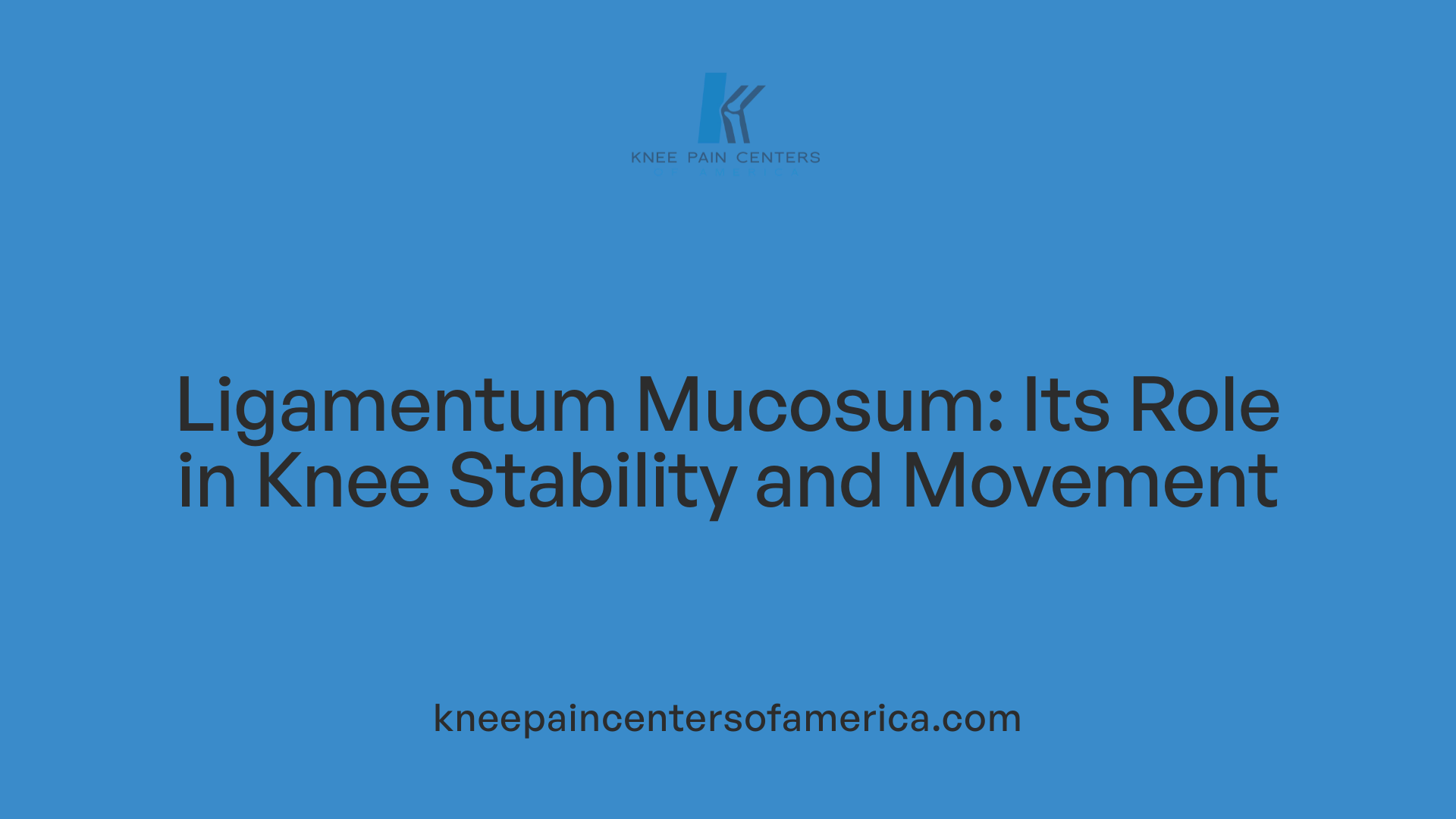
How does the ligamentum mucosum contribute to knee motion facilitation?
The ligamentum mucosum (LM), also known as the infrapatellar plica, originates from the intercondylar notch of the femur and inserts into the infrapatellar fat pad. Situated within the synovial layer of the knee joint capsule, it is covered by synovial membrane and consists of dense connective tissue primarily made up of Type I collagen bundles.
Though small, the LM plays a functional part in facilitating knee motion. It acts as a synovial fold that helps maintain the sliding of joint surfaces during movement, potentially minimizing mechanical interference between internal structures. Its role in knee biomechanics is subtle but important, as it supports smooth motion and may prevent abnormal stress concentration within the joint.
What is the ligamentum mucosum's tensile strength compared to other knee ligaments?
Histological examination reveals that while the ligamentum mucosum is structurally similar to other major knee ligaments, it has comparatively weaker tensile strength. This reduced strength suggests it does not primarily serve a load-bearing or major stabilizing function during high-stress knee activities.
The LM's vascularization and innervation indicate that despite its lower mechanical strength, it can sense joint changes and potentially contribute to joint proprioception or pain signaling. Thus, it has a sensory and mechanical role distinct from the stronger cruciate and collateral ligaments.
Can the ligamentum mucosum stabilize the knee despite weaker tensile strength?
Yes, despite being weaker, the ligamentum mucosum appears to provide a degree of stabilization for the anterior knee compartment. Its various morphological types, such as single band or vertical septum forms, suggest that some configurations provide more structural support than others.
Clinical observations link the presence and type of LM with reduced osteoarthritis levels in regions like the trochlear groove and lateral tibial plateau, implying a protective effect on joint integrity. The LM may contribute to maintaining the alignment and motion path of intra-articular structures, thus preventing undue wear and degeneration.
Furthermore, the LM may influence knee stability subtly by interacting with adjacent soft tissues and synovial structures, helping to modulate joint fluid dynamics and shock absorption. Its contribution to knee motion facilitation, combined with limited stabilization, underlines its importance as a minor yet functional part of the complex knee anatomy.
Association Between Ligamentum Mucosum and Osteoarthritis Levels

How Does the Presence of the Ligamentum Mucosum Affect Osteoarthritis in Specific Knee Regions?
The ligamentum mucosum (LM), connecting the intercondylar notch to the infrapatellar fat pad, has been associated with a reduced incidence of osteoarthritis, particularly in the trochlear groove and lateral tibial plateau regions of the knee. Studies indicate that knees with an intact LM experience lower levels of cartilage degeneration in these areas, suggesting a protective influence that helps maintain joint integrity.
What Is the Relationship Between the Absence of the Ligamentum Mucosum and Osteoarthritis Severity?
Conversely, the absence of the LM correlates with higher overall osteoarthritis levels in the knee joint. This absence removes this potentially stabilizing structure, leading to an increased vulnerability to degenerative changes. Research using the OuterBridge Classification System confirms that knees missing the LM often show more widespread osteoarthritic damage.
Do Different Morphological Types of the Ligamentum Mucosum Influence Osteoarthritis Risk?
The LM exhibits a variety of morphological types, such as separate bands, vertical septa, splits, and fenestrations. Notably, the vertical septum and split variants may provide enhanced mechanical support within the joint, which has been linked to decreased osteoarthritis severity. These configurations potentially contribute to better knee stability, reducing cartilage wear and tear.
Understanding the diverse forms and presence of the ligamentum mucosum is essential for grasping its role in joint health and osteoarthritis progression. This knowledge can inform both diagnostic assessments and therapeutic approaches aimed at preserving knee function.
Clinical Manifestations Linked to Ligamentum Mucosum Abnormalities
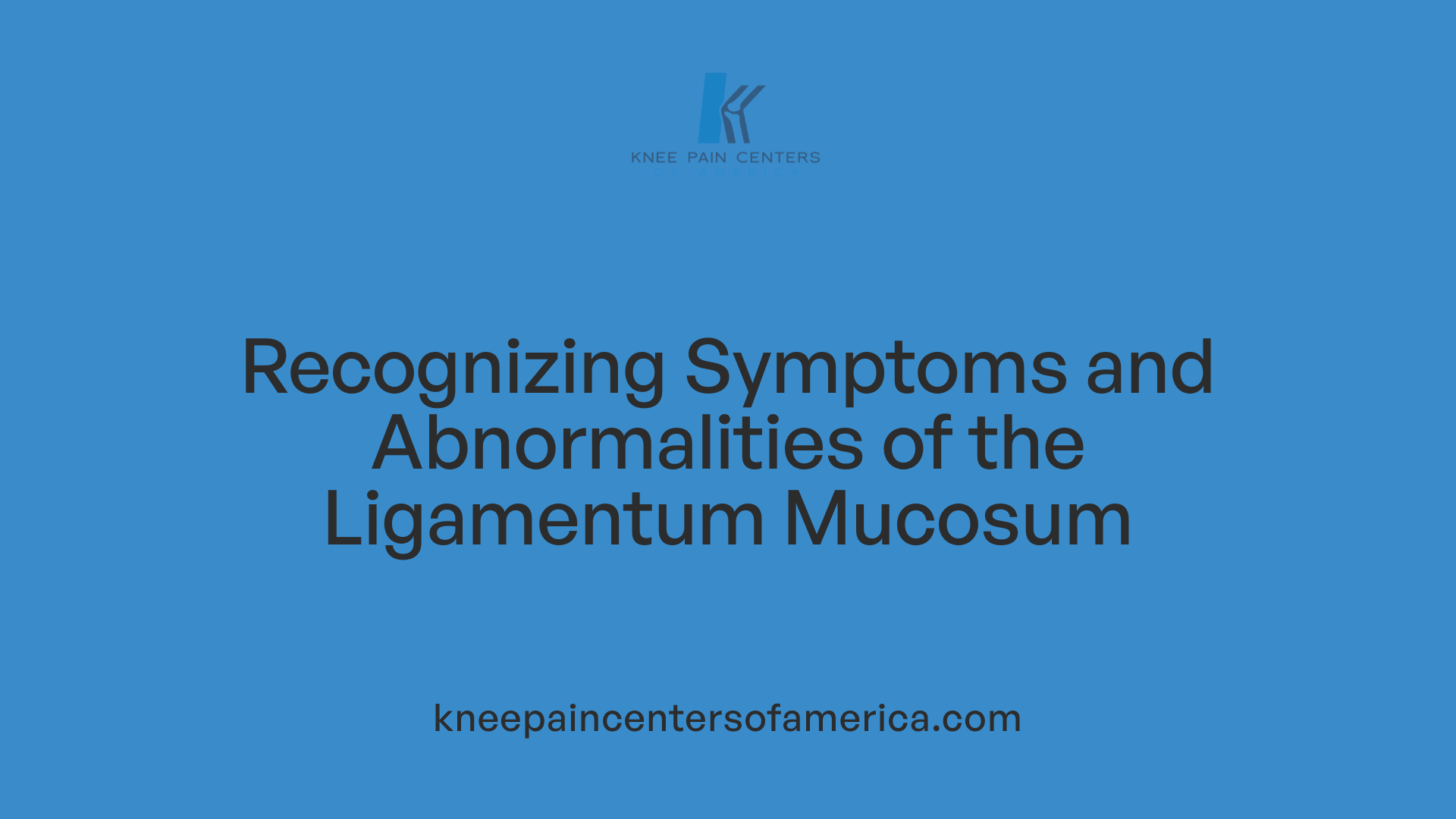
What are the common abnormalities of the ligamentum mucosum?
The ligamentum mucosum (LM), also called the infrapatellar plica, can undergo several pathological changes such as thickening, fibrosis, and rupture. These changes are typically secondary to inflammation or trauma and may alter the ligament's normal structure and function within the knee joint.
What symptoms are associated with ligamentum mucosum abnormalities?
Patients with LM abnormalities commonly present with anterior knee pain (AKP), often without other identifiable pathologies. This pain can be accompanied by swelling and in some cases hemarthrosis, which is bleeding into the joint space. The altered mechanical behavior due to fibrosis or thickened LM may also provoke discomfort by impacting nociceptive nerves in the fat pad and synovial membrane.
Why might ligamentum mucosum abnormalities be misdiagnosed?
The clinical symptoms linked to LM abnormalities—such as pain, clicking, and swelling—are nonspecific and overlap with other internal knee derangements, such as meniscal or ligament injuries. Additionally, because morphologic changes like fibrosis or contracture are present only in a minority of patients, the diagnosis is often challenging. Imaging techniques like MRI can reveal abnormalities such as high T2 signals along the LM indicative of inflammation or rupture, but the subtle nature of these changes can lead to underrecognition.
Understanding LM pathology is crucial in correctly diagnosing cases of idiopathic anterior knee pain to prevent misdiagnosis and to guide effective treatment strategies, including conservative management or arthroscopic intervention when necessary.
Diagnosing Knee Osteoarthritis with Emphasis on Ligamentum Mucosum
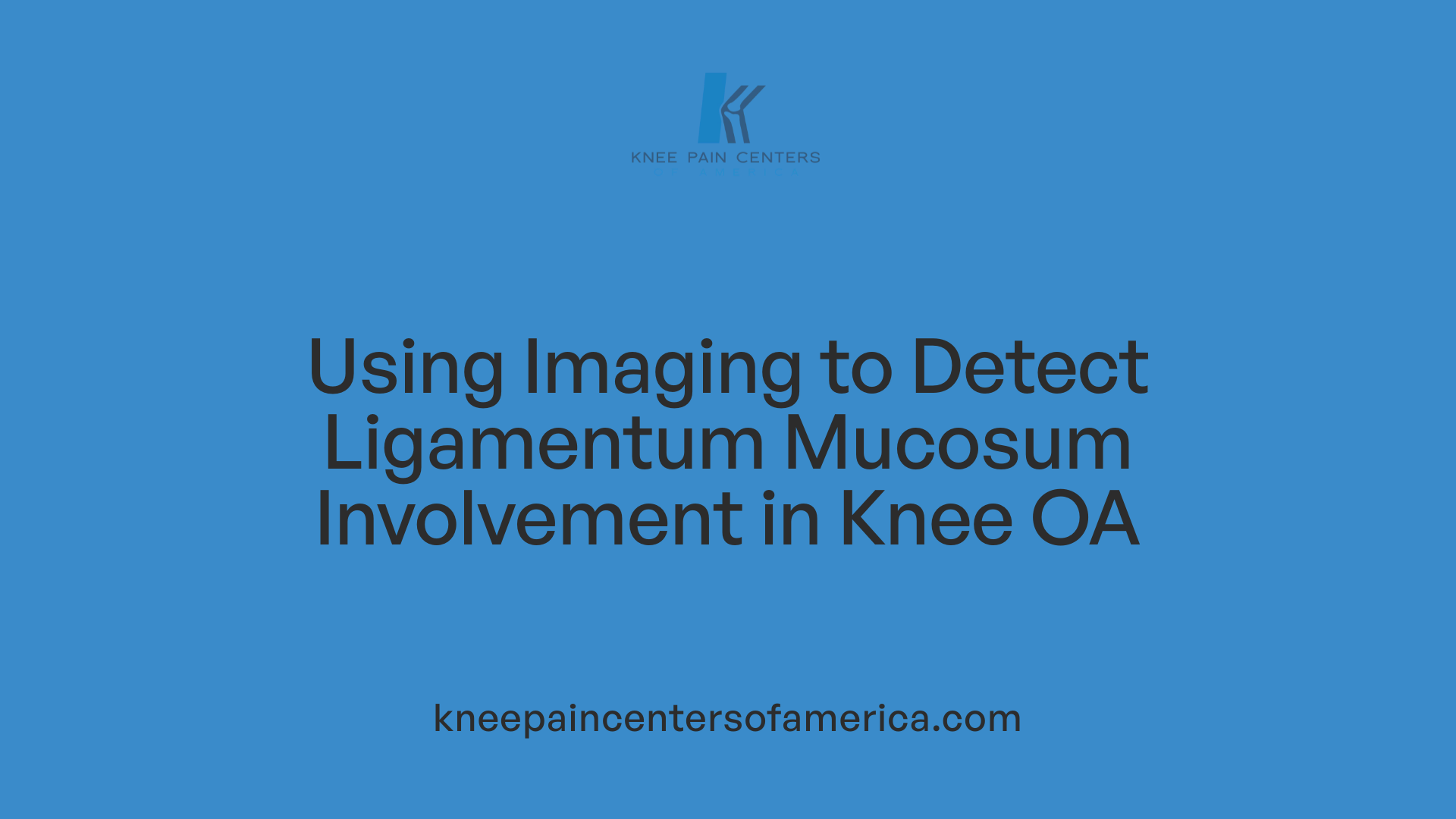
How is osteoarthritis of the knee diagnosed?
Osteoarthritis (OA) of the knee is diagnosed through a blend of patient history, physical examination, and imaging studies. Clinicians first assess symptoms such as persistent pain, joint stiffness, swelling, tenderness, and reduced range of motion. Physical exam findings may include crepitus and localized pain on movement.
Patient history and physical examination
A detailed history focuses on symptom onset, duration, aggravating activities (like squatting or stair climbing), and any preceding injury. Examination targets palpation for tenderness, joint swelling, and evaluation of mobility and stability. Absence or presence of instability helps guide further testing.
Role of imaging: X-ray, ultrasound, MRI
Imaging confirms OA and evaluates severity. X-rays are standard to identify hallmark changes: joint space narrowing from cartilage loss, osteophytes (bone spurs), and subchondral sclerosis. Ultrasound complements by assessing soft tissue inflammation and detecting osteophytes near the joint surface.
MRI offers superior visualization of cartilage, menisci, ligaments, and synovial structures, including the ligamentum mucosum (LM). MRI can detect LM pathology such as thickening, fibrosis, or rupture, which may contribute to anterior knee pain and influence OA progression.
Use of OuterBridge Classification System for osteoarthritis assessment
The OuterBridge Classification is utilized to grade cartilage damage in six knee regions. This systematic approach assists in staging OA severity on imaging, guiding treatment plans.
Identifying LM pathology in MRI
The LM, a synovial fold between the intercondylar notch and the infrapatellar fat pad, can show abnormal high T2 MRI signals if injured or inflamed. Such findings, especially absent other intra-articular injuries, suggest LM involvement in knee pain. Recognizing LM variations and injuries through imaging supports targeted management and may explain cases of unexplained anterior knee discomfort.
Overall, an integrated approach combining clinical evaluation and advanced imaging, with attention to structures like the LM, is essential for accurate diagnosis and treatment planning in knee osteoarthritis.
The Ligamentum Mucosum and Synovial Plicae: Differences and Clinical Implications
What are synovial plicae and how do they develop?
Synovial plicae are membranous folds within the knee joint formed from mesenchymal tissue during embryological development. Typically, these plicae involute but persist in about 50% of individuals. They are covered by synovial membrane and represent normal anatomical variants rather than pathological entities.
What types of synovial plicae exist and how common are they?
There are four recognized types of plicae in the knee:
- Suprapatellar plica: Located above the patella
- Medial patellar plica: The most common and clinically significant
- Infrapatellar plica (ligamentum mucosum): Extends from the intercondylar notch to the infrapatellar fat pad
- Lateral plica: Rarely observed
Each type can vary morphologically. The medial plica is most frequently injured, especially in cases of plica syndrome.
How is the ligamentum mucosum related to other plicae?
The ligamentum mucosum (LM), also called the infrapatellar plica, is a specific type of synovial plica within the knee. Unlike other plicae, it originates from the intercondylar notch of the femur and inserts into the infrapatellar fat pad. It shows considerable morphological variation including single and bifurcated bands. While all plicae represent synovial folds, the LM is somewhat unique due to its ligamentous composition and tendon-like characteristics.
What syndromes are associated with synovial plicae?
Although synovial plicae are usually asymptomatic, they can become inflamed or irritated due to trauma, overuse, or repetitive knee movements, leading to plica syndrome. This condition presents with anterior knee pain, clicking, swelling, and restricted motion, especially worsened by activities such as squatting or stair climbing. Diagnosis often involves physical examination and MRI imaging to assess plica thickness and joint involvement.
In summary, synovial plicae are normal anatomic synovial folds, with the ligamentum mucosum representing a specialized infrapatellar plica. Understanding the types and clinical relevance of these folds aids in diagnosing knee pain syndromes such as plica syndrome, which may require targeted management.
Plica Syndrome: Symptoms, Diagnosis, and Its Link to Ligamentum Mucosum
What Are the Common Symptoms of Plica Syndrome?
Plica syndrome often presents with an array of symptoms affecting knee function. Patients typically report pain localized around the knee, which may be sharp or achy. This pain is often accompanied by mechanical sensations such as clicking and popping during knee movement. Swelling and a reduced range of motion can occur, contributing to feelings of instability. These symptoms are usually aggravated by activities involving knee bending or pressure, like squatting, climbing stairs, or sitting for extended periods.
How is Plica Syndrome Diagnosed?
Diagnosing plica syndrome involves a combination of physical examination and imaging techniques. Clinicians frequently use specific physical assessments such as the Medial Plica Test to detect tenderness or abnormal movement of the plica. Magnetic Resonance Imaging (MRI) is instrumental in evaluating the thickness and extension of the plica, as well as identifying any associated joint pathologies. MRI can also visualize the ligamentum mucosum (LM), providing insights into inflammation or injury that might contribute to symptoms.
What Is the Prevalence of Plica Syndrome?
Plica syndrome is relatively uncommon but notable among knee joint disorders. Arthroscopic studies report a prevalence ranging between 3.8% and 5.5%, indicating it as an important differential diagnosis in patients with anterior knee pain. The infrapatellar plica, synonymous with the ligamentum mucosum, is a significant focus in these cases, sometimes contributing directly to symptomatology when thickened or injured.
What Is the Ligamentum Mucosum’s Role and Clinical Importance?
The ligamentum mucosum, also known as the infrapatellar plica, extends from the intercondylar notch to the infrapatellar fat pad. Its variable morphology can affect knee kinetics and stability. Clinically, the LM's thickening, fibrosis, or rupture may cause anterior knee pain, often in the absence of other identifiable pathologies. Understanding the LM's anatomy and variations aids in diagnosing plica syndrome and planning appropriate treatment, which can include conservative management or arthroscopic excision to alleviate symptoms.
Conservative Management of Knee Pain Involving Ligamentum Mucosum and Plica Syndrome
Rest and activity modification
When managing knee pain related to the ligamentum mucosum (LM) and plica syndrome, initial treatment often involves rest and modification of activities that exacerbate symptoms. Avoiding repetitive knee movements, squatting, stair climbing, and prolonged sitting can reduce irritation to the synovial plicae and inflamed LM.
Use of NSAIDs for inflammation and pain control
Nonsteroidal anti-inflammatory drugs (NSAIDs) are commonly used to control inflammation and relieve pain associated with thickened or injured plicae and ligamentum mucosum. NSAIDs help reduce swelling within the knee joint, which can improve mobility and decrease discomfort.
Physiotherapy focusing on quadriceps strengthening and flexibility
Physical therapy plays a crucial role in conservative care, particularly exercises that strengthen the quadriceps muscles and enhance knee flexibility. Strengthening surrounding muscles helps stabilize the knee, potentially reducing stress on the LM and plicae. Stretching routines improve joint range of motion and decrease symptoms like clicking, popping, and feelings of instability.
Role of supportive devices
Supportive devices such as knee braces or orthotic inserts may be recommended to provide additional joint stability and redistribute load during activity. Combining these with physiotherapy can effectively alleviate symptoms and prevent further aggravation.
Common Medical Treatments for Knee Pain
Common treatments for knee pain include a spectrum of approaches starting with conservative measures like physical therapy and NSAIDs, as mentioned above. Other medical options include acetaminophen and duloxetine for pain management, corticosteroid injections for short-term relief especially in osteoarthritis, and viscosupplementation with hyaluronic acid. When conservative management is ineffective, surgical interventions such as arthroscopic resection of the plica or ligamentum mucosum, as well as more invasive knee surgeries, might be considered.
Overall, individualized treatment plans often progress from conservative to surgical methods based on symptom severity and response to therapy. Conservative management focusing on rest, NSAIDs, physiotherapy, and supportive aids remains the first-line approach for many patients with ligamentum mucosum and plica syndrome-related knee pain.
Surgical Treatment Options Targeting the Ligamentum Mucosum and Plica Syndrome

When is surgery considered for patients with knee osteoarthritis?
Surgery is usually considered when conservative treatments fail to alleviate symptoms. This includes patients who experience persistent pain, decreased mobility, and reduced quality of life despite interventions such as physiotherapy, weight management, pain medication, and joint injections. Surgical options are tailored based on disease severity and patient-specific factors, with the goal of improving function and reducing pain.
Arthroscopic excision of thickened or symptomatic ligamentum mucosum (LM)
When the ligamentum mucosum becomes thickened, fibrotic, or injured, it can contribute to anterior knee pain and possibly accelerate osteoarthritis progression. Arthroscopic excision or resection of the LM has been shown to relieve idiopathic anterior knee pain when no other pathology is identified. This minimally invasive procedure targets the removal of inflamed or hypertrophied tissue, reducing mechanical irritation within the joint.
Surgical untethering of the infrapatellar fat pad and ligamentum mucosum
The infrapatellar fat pad, together with the LM, acts as a hydraulic shock absorber within the knee. When these structures become tethered or contracted, they can cause nociceptive pain. Surgical untethering and release of the LM and fat pad have been used to alleviate anterior knee pain by restoring normal mechanical behavior and reducing pain signals. This approach is especially beneficial when conservative management has failed.
Indications for surgery after failed conservative management
Surgery is typically recommended for patients with persistent symptoms despite rest, NSAIDs, physiotherapy focused on strengthening and flexibility, and activity modification. Those presenting with mechanical symptoms like popping, clicking, and limited range of motion attributable to plica syndrome or LM abnormalities are candidates for arthroscopic intervention. The presence of additional intra-articular pathologies may influence outcomes but does not preclude surgery.
Postoperative rehabilitation and physiotherapy
Following surgical procedures targeting the LM and plica, physiotherapy plays a vital role. Rehabilitation focuses on restoring knee range of motion, strengthening the quadriceps and surrounding musculature, and gradually returning to normal activities. This helps prevent recurrence of symptoms and supports long-term joint stability and function.
| Treatment Aspect |
Description |
Clinical Importance |
| Arthroscopic LM excision |
Removal of thickened or fibrotic ligament to relieve pain |
Reduces mechanical irritation causing pain |
| Untethering fat pad and LM |
Release of contracted tissues acting as hydraulic shock absorbers |
Improves joint mechanics and pain control |
| Indication criteria |
Persistent symptoms after conservative care; mechanical signs of plica syndrome or LM pathology |
Ensures surgery is reserved for appropriate cases |
| Postoperative physiotherapy |
Rehabilitation with strengthening, flexibility, and range of motion exercises |
Enhances recovery and prevents symptom recurrence |
Advanced Imaging Techniques and Their Role in Assessing Ligamentum Mucosum Injury

How Does MRI Characterize an Injured or Inflamed Ligamentum Mucosum?
Magnetic Resonance Imaging (MRI) plays a crucial role in detecting injuries to the ligamentum mucosum (LM), also known as the infrapatellar plica. Normally, the LM appears as a thin, low-signal, curvilinear structure on MRI due to its dense connective tissue composition. When injured or inflamed, it manifests a distinct high T2 signal along its course. This signal increase indicates fluid accumulation, edema, or inflammation within the ligament structure.
What Does a High T2 Signal Indicate About LM Trauma?
A prominent high T2 signal in the infrapatellar plica region is indicative of trauma or inflammation. Such findings may correspond to thickening, fibrosis, or even rupture of the LM. These alterations reflect structural changes secondary to injury. Recognizing these abnormalities helps pinpoint the LM as a source of anterior knee pain, especially when other knee pathologies are absent.
How Does Imaging Help Exclude Other Internal Knee Derangements?
MRI not only detects LM abnormalities but also helps exclude other internal derangements such as meniscal tears or ligament injuries. The isolation of high T2 signal changes confined to the LM without accompanying abnormalities suggests that the plica itself may be responsible for symptoms. This differentiation is vital as LM injuries can be subtle and are often misdiagnosed.
What Is the Impact of LM Abnormalities on MRI Interpretation for Knee Injuries?
Variations or injuries of the LM can influence the interpretation of MRI scans by mimicking or masking other knee conditions. For instance, a bifurcated or thickened LM variant might be confused with pathological findings or complicate assessments of the anterior cruciate ligament. Awareness of LM morphology and its MRI appearance is essential for accurate diagnosis and for guiding appropriate management strategies for anterior knee pain and osteoarthritis progression.
Ligamentum Mucosum as Donor Tissue and Its Potential in Regenerative Therapies
Histological Suitability of LM Tissue for ACL Reconstruction
The ligamentum mucosum (LM) exhibits histological characteristics that make it a candidate for use as donor tissue in anterior cruciate ligament (ACL) reconstruction. Composed mainly of dense regular connective tissue with a predominance of type I collagen and a smaller amount of type III collagen, the LM resembles other knee ligaments in structure, though it has weaker tensile strength. It contains fibrocytes, blood vessels, and nerves, indicating a viable biological matrix for grafting. This similarity suggests the LM could integrate well when transplanted, offering a promising autograft or allograft option for ACL surgical treatments.
Implications for Surgical Treatments Using LM Tissue
Leveraging the LM as donor tissue could expand surgical options for knee ligament repair. Its accessibility within the knee joint and relatively consistent presence are advantageous. Using LM tissue might reduce donor site morbidity commonly seen with traditional grafts like hamstring or patellar tendons. Furthermore, harvesting the LM could potentially be combined with arthroscopic procedures, minimizing invasiveness and promoting faster recovery. The variability in LM morphology, such as single or bifurcated bands, emphasizes the need for personalized surgical planning to optimize graft compatibility and joint stability.
Connection to Recent Advancements in Knee Osteoarthritis Treatments
Emerging treatments for knee osteoarthritis prioritize preservation and restoration of joint function through regenerative techniques. The LM’s potential as a donor ligament dovetails with regenerative therapies such as platelet-rich plasma (PRP) injections and stem cell treatments that aim to repair cartilage and improve joint health. Moreover, minimally invasive procedures like knee embolization reduce synovial inflammation, complementing surgical approaches that restore ligament integrity. Integrating LM-based tissue grafting with these methods holds promise for comprehensive management, potentially slowing osteoarthritis progression and alleviating symptoms more effectively by combining mechanical stabilization with biological repair.
Lifestyle Modifications to Support Knee Joint Health and Osteoarthritis Management
What lifestyle changes can help manage knee osteoarthritis?
Managing knee osteoarthritis (OA) effectively involves several lifestyle adjustments that focus on reducing joint stress and enhancing knee stability.
Importance of weight management
Maintaining a healthy weight is essential because excess body weight increases pressure on the knee joints, accelerating cartilage wear and inflammation. Weight reduction can significantly decrease pain and improve mobility in those with OA.
Low-impact exercises to strengthen knee-supporting muscles
Engaging in low-impact exercises such as swimming, cycling, walking, and gardening helps strengthen the muscles around the knee. Stronger muscles provide better joint support and improve flexibility, which can alleviate symptoms and slow OA progression. Physiotherapy exercises targeting the quadriceps and hamstrings are particularly beneficial.
Avoidance of activities exacerbating symptoms
Avoid activities that intensify knee pain or inflammation. Movements like deep squatting, kneeling, or repetitive high-impact actions can worsen symptoms by stressing the joint and inflaming structures like the ligamentum mucosum and synovial plicae.
Use of supportive devices and prevention strategies
Using knee braces, shoe insoles, or orthotic devices can help stabilize the joint and distribute load more evenly. Protecting the knees from injury through proper technique during physical activities and early intervention when pain arises contributes to better long-term outcomes.
Combining these approaches—weight control, tailored exercise, symptom-aware activity modification, and supportive devices—creates an effective strategy to manage knee OA symptoms and improve patients' quality of life.
Emerging Therapeutic Approaches and Future Directions in Ligamentum Mucosum Research
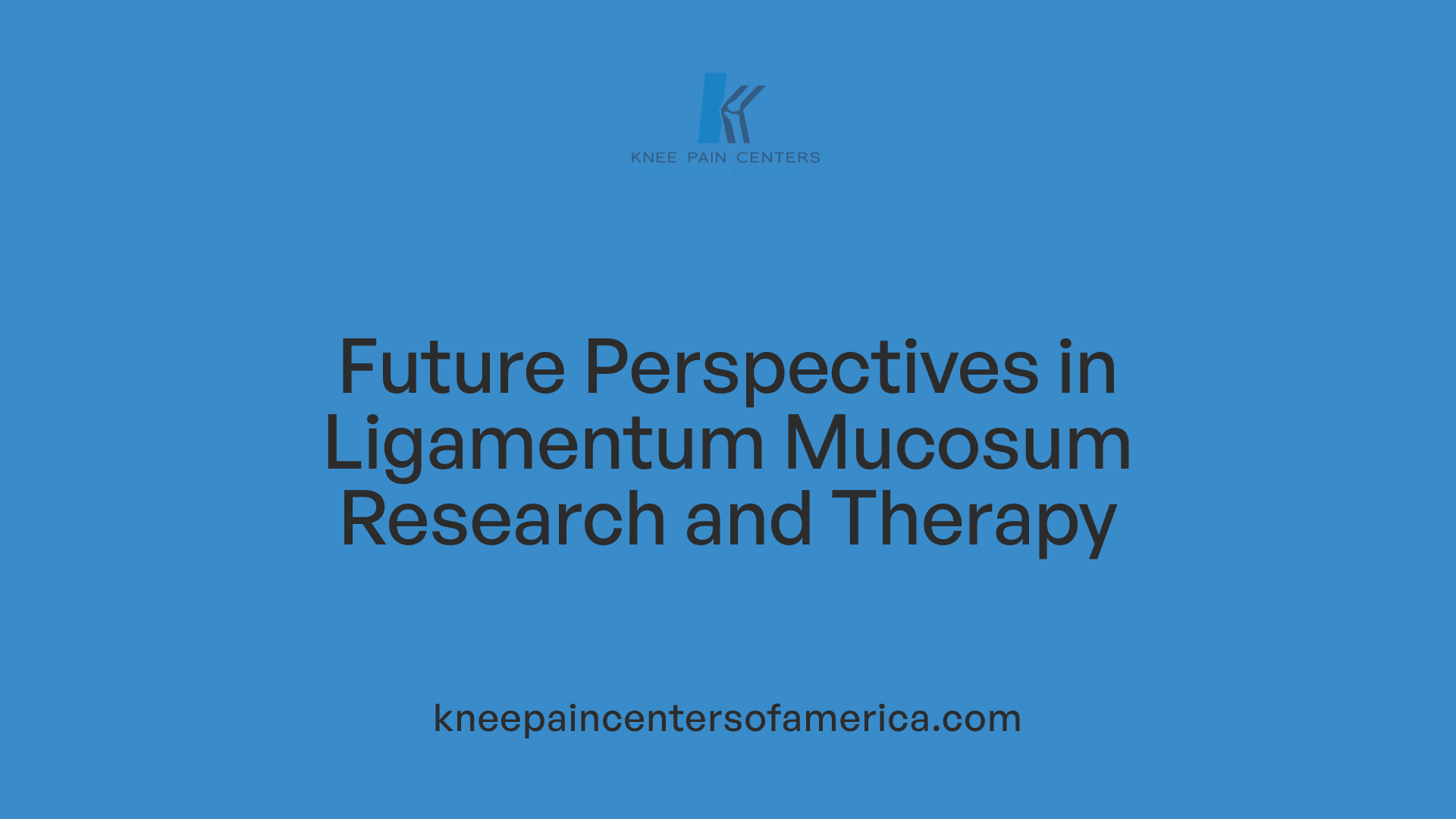
Potential of LM-targeted therapies to reduce osteoarthritis progression
Recent studies highlight the ligamentum mucosum (LM) as a protector against osteoarthritis, especially in the trochlear groove and lateral tibial plateau regions. This protective role positions the LM as a promising target for therapies aimed at slowing or preventing osteoarthritis progression. Surgical interventions such as arthroscopic release or resection of thickened or traumatized LM have shown potential in alleviating anterior knee pain and possibly reducing degenerative changes by restoring normal knee mechanics.
Importance of understanding LM morphology in personalized treatment
The LM exhibits significant morphological variability, including types such as single band, bifurcated, vertical septum, or even absence. Certain types like the vertical septum and split ligaments may provide enhanced joint support and correlate with lower osteoarthritis levels. Recognizing these morphological differences is crucial for clinicians to tailor treatments to individual patients, optimizing outcomes. For example, the bifurcated LM associated with the anterior cruciate ligament (ACL) influences both knee stability and imaging interpretation, requiring personalized diagnostic and therapeutic approaches.
Prospects for minimally invasive and regenerative interventions
With advancements in arthroscopic techniques, minimally invasive procedures targeting the LM are increasingly viable. These include arthroscopic untethering of the infrapatellar fat pad and selective release or excision of pathological LM tissue. Additionally, given the ligament's histological similarity to other knee ligaments and its rich vascularization, the LM holds potential as a donor tissue in regenerative medicine, such as ACL reconstruction. Future research is also focusing on regenerative therapies aimed at restoring LM integrity to preserve knee stability and prevent osteoarthritis progression.
Summary and Outlook on Ligamentum Mucosum in Knee Health
The ligamentum mucosum, a versatile synovial fold within the knee joint, plays an underappreciated yet pivotal role in knee stability, pain syndromes, and osteoarthritis progression. Recognizing its anatomical variations and potential pathological changes allows for improved diagnosis and targeted treatment of anterior knee pain and degenerative joint disease. Through advanced imaging, careful clinical assessment, and evolving surgical and regenerative therapies, clinicians can better manage knee osteoarthritis with consideration of ligamentum mucosum involvement. Future research into its biomechanics and therapeutic modulation promises to enhance patient outcomes, making the ligamentum mucosum a critical focus in orthopedic and rehabilitation medicine.
References